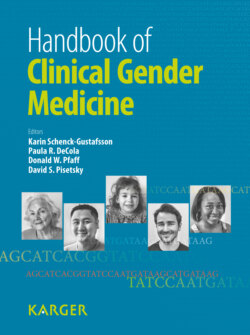Читать книгу Handbook of Clinical Gender Medicine - Группа авторов - Страница 63
На сайте Литреса книга снята с продажи.
Molecular Biology
ОглавлениеThe AR protein is a member of the steroid hormone-activated transcription regulator family, a subset of the superfamily of ligand-dependent transcription factors. Receptors such as estrogen receptor-α (ER-α) and ER-β, mineralocorticoid receptors, glucocorticoid receptors, and progesterone receptors affect transcription through steroid hormone-receptor interaction. The AR protein, like other steroid hormone receptors, consists of three functional domains. The carboxy-terminal (ligand-binding domain) is responsible for androgen binding, the central domain accounts for DNA binding (DNA-binding domain), and the amino-terminal plays a role in transcriptional activation. Together, the three functional domains determine the ability of androgen-AR interactions to regulate transcription. The AR protein is encoded by 8 exons in a single gene located on Xq 11-12. The most frequently seen mutations are nonsense or missense point mutations, with clusters of mutations seen on exons 5 and 7 which code for the ligand-binding domain of the AR. Mutations of the AR gene result in abnormal AR protein binding capabilities which leads to an inability of androgen hormones such as testosterone and DHT to properly regulate transcription. Defects in androgen-AR protein binding directly affect the development of urogenital mesenchyme into male or female external genitalia in 46, XY genotypical males [3].
The role of androgens in sexual differentiation was first elucidated in 1940 by Jost [2] who concluded that the testes were responsible for external genital differentiation through secretion of androgens. Recent studies have shown that androgen-related effects in a cell or tissue may be regulated through paracrine signaling by neighboring cells. In male genital differentiation in particular, the prostate demonstrates mesenchymal (stromal)-epithelial interactions that appear to be an integral part of the epithelium’s differentiation into characteristic branched ducts of the prostate. Steroid hormones such as 17β-estradiol and progesterone are capable of altering epithelial proliferation and organization through paracrine signaling of stromal cells. This paracrine signaling appears to be influenced by steroid-steroid hormone receptor interaction in the nearby cells.
There is also evidence that androgens have direct, non-AR-regulated effects on cells. Direct intracellular response to androgens can occur quickly, within seconds to minutes. This so-called ‘nonclassical’ androgen response pathway can involve several mechanisms such as activation of sex hormone-binding globulin receptors, activation of phosphatidylinositol 3-OH kinase (PI3-K) signaling, and modulation of voltage-and ligand-gated ion channels and transporters. The idea that the role of AR extends beyond the classic androgen-AR mechanism of transcription regulation is intriguing in partial androgen insensitivity syndrome (PAIS). It is possible the varied phenotypical presentations seen in PAIS are in part related to other cellular signaling roles separate from AR that androgens play in genital differentiation.
